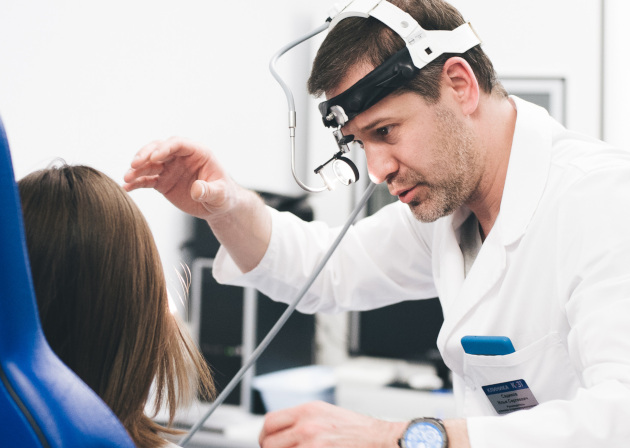Exudative otitis media

specialists

equipment

treatment

При отоскопии:
- Нарушение подвижности барабанной перепонки
- За барабанной перепонкой может присутствовать уровень воздух-жидкость, иногда с пузырьками. Жидкость чаще желтого цвета
- Барабанная перепонка в нормальном или втянутом положении
- Помутнение барабанной перепонки
Дополнительные обследование:
- Тимпанометрия (тип В)
- Аудиологическое обследование (кондуктивная тугоухость)
- Эндоскопический осмотр полости носа и носоглотки (аденоиды, гипертрофия трубных валиков)

Экссудативный средний отит обычно разрешается спонтанно. При отсутствии факторов риска показано динамическое наблюдение.
Факторы риска:
- Стойкое снижение слуха по причинам, не связанным с экссудативным средним отитом
- Неврологические нарушения развития (расстройства аутического спектра, синдром Дауна)
- Аномалии строения черепа (расщелина твердого неба)
- Задержка речевого развития
- Нарушение зрения, не поддающееся коррекции
При наличии сопутствующей патологии полости носа и носоглотки – соответствующее лечение.
При неэффективности выжидательной тактики показано хирургическое лечение: шунтирование барабанной полости, эндоскопическая баллонная дилатация евстахиевой трубы.

- Presence of risk factors for developmental and learning disabilities in children
- Age < 3 years
- Structural changes in the eardrum, tympanic cavity
- Degree of hearing loss > 40 dB
- Bilateral otitis media with effusion > 3 months
- Unilateral otitis media with effusion > 6 months
- Recurrent otitis media with effusion (6 months in total per year, ≥3 episodes within 6 months or ≥4 episodes within 12 months)

How is an appointment with an otolaryngologist at K+31?
Our doctors

This award is given to clinics with the highest ratings according to user ratings, a large number of requests from this site, and in the absence of critical violations.

This award is given to clinics with the highest ratings according to user ratings. It means that the place is known, loved, and definitely worth visiting.

The ProDoctors portal collected 500 thousand reviews, compiled a rating of doctors based on them and awarded the best. We are proud that our doctors are among those awarded.
Make an appointment at a convenient time on the nearest date
Price


































Etiology and clinical picture
A multifactorial disease, the development of which involves: inflammation, infection, hyperproduction of mucus in the middle ear cavity, features of innate immunity, etc.
Dysfunction of the Eustachian tube is the main factor predisposing to exudative otitis media.
Often, exudative otitis media occurs after acute otitis media and can persist for several weeks.
As a rule, the disease is asymptomatic. Parents may notice that the child has started asking questions again, or may notice a delay in speech development. Sometimes there are complaints about a feeling of pressure in the ear, its congestion, or tinnitus. In rare cases, imbalance, stumbling, and falling are possible.